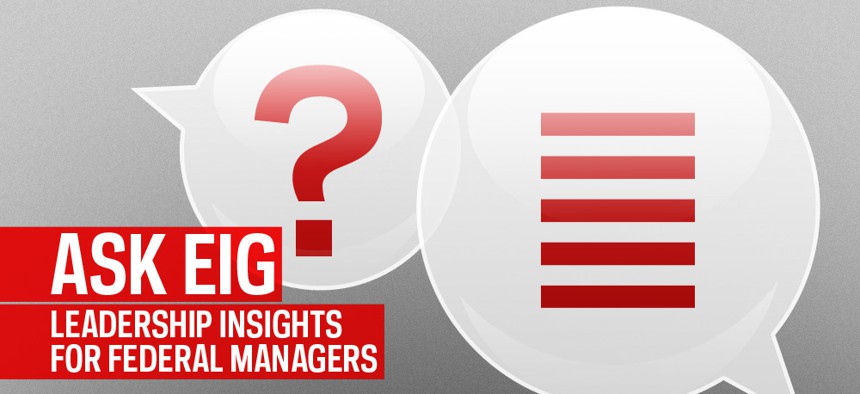Ask EIG: How Do You Create a Culture That Values Diversity?
A look at the difference between “buy-in” and “bee-in."
![]()
Ask EIG is a partnership between Government Executive and the management experts at Brookings Executive Education.
Dear EIG,
How do you create an organization culture that values diversity and inclusion?
-Anonymous
The phrase “diversity and inclusion” evokes emotional responses from many corners. Passionate supporters tout diversity and inclusion as a moral imperative or as the new source of competitive advantage for every organization that adopt it. From other corners, ardent opponents view diversity and inclusion as a manipulation to enact hiring quotas, increase organizational costs, and impose cultural and moral values that conflict with their own as a condition of employment. But, there is another way to look at this call for action without eliciting emotions from any of these corners.
(HAVE A QUESTION? Send your management questions to AskEIG@govexec.com.)
Describing the difference between “buy-in” and “bee-in” can illuminate the central leadership idea behind the call for diversity and inclusion. Buy-in is a common phrase that most of us often use in the work place—“Hey Carolyn, we need your buy-in to implement this new program.” The phrase initially seems innocuous as we are asking for help to do something work related.
Yet from a different perspective, buy-in can imply that we excluded Carolyn from the decision-making process and, by implication, viewed her potential contributions as not valuable enough to arrant including her from the beginning. Now, with the decision made, Carolyn is like a cog in the machine and we need her to move in order to implement what we already decided. Buy-in communicates that we want Carolyn to “purchase” our decision even though it may come at a high emotional and personal cost to her.
Seeking buy-in is a common approach in organizations with political, command and control, and compliance-based structures. To be clear, sometimes these organizational structures that rely on power are necessary for making decisions efficiently. For instance, command and control can be effective in certain military and others situations where quick decision-making is key to victory, success, or survival. However, in an increasing number of organizational settings, hierarchical power-based structures no longer offer the most effective organizational approach to creating value.
Bee-in, which is an expression I coined a few years ago in several courses I teach at Brookings Executive Education (hence the name BEE), reflects a set of processes where all relevant actors are included from the beginning. Such processes enable groups to collectively and comprehensively formulate challenges. Then, groups develop comprehensive solutions. Bee-in processes include all relevant stakeholders and appreciate the diversity of a team’s information, knowledge, experience, and perspectives. As a result, these processes cause team members to own the challenge and increase the likelihood of successfully implementing the solution.
Seeking bee-in is a common approach found in many kinds of organizations. For instance, team-based structures, autonomous work teams, agile development organizations, as well as many other types of organizations use bee-in processes to generate commitment and collaboration. While bee-in processes can be time consuming especially in the early phases of formulating challenges, the time is not misspent. In fact, the time investment builds trust and creates understanding, which are known to ultimately speed implementation efforts and dramatically increase the likelihood of great execution.
You asked how to create a culture that values diversity and inclusion? My belief is if you lead through bee-in processes with all your relevant stakeholders, you will make an important and substantial step toward achieving your goal. When used consistently, these processes foster a culture of mutual respect as well as an appreciation for the information, knowledge, experience, and perspectives of all relevant stakeholders, which are the fundamental ingredients for valuing diversity and inclusion.
While I hope adopting bee-in approaches sounds attractive, sometimes adopting them can be difficult in federal agencies. Some leaders more comfortable with a command and control approach to decision-making may want bee-in but inadvertently undermine it when they overrule group consensus without adequate conversation to explain why. Political appointees with limited time windows to implement desired policies all too often resort to using power to get things done, which undermines bee-in. And, underinvestment in training and development, especially with respect to cross training and leadership, may unnecessarily work against the adoption of bee-in processes as people have little practice or understanding of these processes. In such instances, much effort and conversation are needed to coach and guide leaders in their decision-making processes so they understand both the short- and long-term implications of their leadership approach.
In my view, the ultimate goal of diversity and inclusion is the full engagement and utilization of employees and their capabilities. For an organization to value diversity and inclusion, leaders must choose to adopt, invest in, and sustain “bee-in” decision making processes that build trust and create understanding. Doing so consistently offers a way to achieve full engagement and utilization of all of your employees.
Duce a mente (may you lead by thinking),
Jackson Nickerson
In partnership with Brookings Executive Education, Excellence in Government is now taking, and answering, your most difficult management questions. Send your questions to AskEIG@govexec.com.








